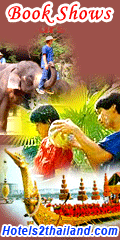Thai airlines
Bangkok Airways [9] promotes itself as "Asia's Boutique Airline", and has a monopoly on flights to its own airports at Ko Samui, Sukhothai and Trat. Their Discovery Airpass [10] with fixed per segment rates can be good value, especially if used to fly to Siem Reap (Cambodia) or Luang Prabang (Laos). Note that the Discovery Airpass can now only be purchased from abroad.
SGA Airline [11] Now joint with Nok Air, is currently the only passenger carrier offering daily flights to/from Hua Hin Airport. New routes also between Chiang Mai-Pai, Chiang Mai-Mae Hong Sorn.
Nok Air [12] took to the skies in 2004 sporting lurid paints scheme with a bird's beak painted on the nose. Owned mostly by Thai Airways, they compete with Air Asia on price and, with a fairly comprehensive domestic network, are a pretty good choice overall. However, they've run into some serious turbulence in 2008, cutting their flights by two thirds, and their continued survival is now in doubt.
PB Air [13] flies domestically to Lampang, Nan, Mae Hong Son, Roi Et, Sakon Nakhon, Nakhon Phanom, Buriram, Nakhon Si Thammarat, and also to Danang (Vietnam).
Thai AirAsia [14] is a budget airline offering discounted tickets if booked well in advance, but prices rise steadily as planes fill up. They fly from Bangkok to a number of places domestically, as well as Cambodia, China and Macau, Malaysia, Myanmar, Singapore, and Vietnam. Keep in mind the price displayed in your search results is only the base fare, additional "taxes and fees" mean the true price will be appreciably higher. On-line booking is straightforward but must be done at least twenty-four hours in advance; ticket sales at the check-in desk close one hour before the departure time.
Thai Airways [15] is the most reliable, frequent, and comfortable Thai airline, but usually more expensive than the alternatives. Travel agents can usually sell only THAI Airways tickets; you can also book on-line.
Thai Railway
State Railway of Thailand [16] (SRT) has a 4000-km network covering most of the country, from Chiang Mai in the north all the way to (and beyond) the Malaysian border in the south. Compared to buses, most trains are relatively slow, but safer. Point-to-point fares depend on the type (speed) of the train and the class of the carriage. There are three main classes:
- First class (chan neung) 2-berth sleeping compartments with individually regulated air conditioning are available on some trains, but prices are sometimes matched by budget airfares.
- Second class (chan song) is a good compromise, costing about the same as 1st class buses and with a comparable level of comfort. Some 2nd class trains are air-con, others aren't; air-con costs a little more. Second class sleeper berths are comfortable and good value, with the narrower upper bunks costing a little less than the wider lower bunks. Food and WCs are basic. 2nd class Express Railcar trains have reclining seats and refreshments are included in the fare; unlike all other Thai passenger trains, they can match buses for speed, but cannot carry bicycles.
- Third class (chan saam) is the cheapest way to travel in Thailand, with virtually nominal fares, and can be great fun. Sometimes packed with tuk-tuk drivers heading home with a sack of rice and a bottle of cheap whisky for company, as a farang (foreigner of European ancestry) you're guaranteed to be the center of attention - quite enjoyable in small doses, but 10 hours of this might be a bit much. Some 3rd class trains have wooden seats, others are upholstered; some services can be pre-booked, others cannot; refreshments are available from hawkers who roam the aisles.
Pre-booking is recommended, especially for sleeper berths. Many travel agencies will spare you the trouble of travelling to the station to buy tickets for a service fee (often 100 baht/ticket), or you can reserve with SRT directly by e-mail at passenger-ser@railway.co.th for a 200 baht/booking surcharge.
Bus
Buses travel throughout the country and the government's bus company BKS (บขส Baw Kaw Saw), known in English simply as the Transport Company [17], has a terminal in every town of any size.
Generally speaking, BKS buses are the best option for both price and comfort. There are also many private bus companies, who mainly compete on price and are less reliable in terms of amenities, schedules and safety. In particular, beware of non-government "VIP" buses, which may be nothing of the sort. A special subclass are the cheap Khao San Road buses, targeted at backpackers. These are the slimiest of the lot and you may find that your supposed VIP bus is in fact a cramped minivan - after paying in advance, that is.
The basic bus types are:
- Local - relatively slow, can be cramped when full (nevertheless there's always room for one more), and stop at every village and cowshed along the way. Many are of larger songthaew flavour. Not suitable for long-distance travel, but may be the only cheap way to get around locally.
- Express (rot duan) - skip some stops, but no other frills. Identifiable by their orange colour. Size varies, with the largest having around 65 seats (five seats per row) as well as an open space across the width of the bus by the back door for you to sling your rice / chickens / bicycle / backpack.
- Second class (chan song) - skip more stops, but often take a less direct route than 1st class / VIP / S-VIP. Blue and white with an orange stripe, usually 45-48 seats per bus, air conditioned (some provide blankets, some do not), and most have no on-board toilet (however the frequent stops mean this isn't a problem).
- First class (chan neung) - generally take the most direct routes and make very few stops. Blue and white in colour, air conditioned, blanket usually provided, fewer (larger, longer pitch) seats (typically 40, but some double-decker types seat 60+), snack and drinking water included. Most have a toilet on board (only very short haul services sometimes do not).
- "VIP" - as per 1st class, but with only 32-34 seats, which have more leg room and recline further. Basic meal included and freshly laundered shrink-wrapped blanket provided. Also blue and white (or sometimes blue and silver) but usually signed "VIP".
- "S-VIP" - Super-VIP is very similar to VIP, except there are only 24 seats, which are wider - the aisle is offset, each row having a pair of seats on the right and only a single seat on the left. Primarily used on overnight services.
Some buses may have TVs and sound systems blaring, so earplugs are well worth having, just in case.
On long-haul buses, if your ticket allocates you a front seat, you may have to switch seats if a monk boards.
Tuk-tuk

The name tuk-tuk is used to describe a wide variety of small/lightweight vehicles. The vast majority have three wheels; some are entirely purpose-built (eg the ubiquitous Bangkok tuk-tuk), others are partially based on motorcycle components (primarily engines, steering, front suspension, fuel tank, drivers seat). A relatively recent development is the four wheeled tuk-tuk (basically a microvan-songthaew) as found in Phuket.
Taxi
Metered taxis are ubiquitous in Bangkok and starting to become more popular in Chiang Mai, but rare elsewhere in the country. When available, they are an excellent means of transport - insist on the meter. Beware of taxis which idle around touristy areas and wait for people. They are looking for a tourist who will take their taxi without using a meter. Always use the meter!
Rental car
Driving your own car in Thailand is not for the faint-hearted, and many rental companies can supply drivers at a very reasonable price. Prices without insurance for a self-driven car start from around 800 baht/day for small cars, and from as little as 600 baht/day for open-top jeeps; cars with insurance start at just under 1000 baht/day, and come down to around 5600 baht/week or 18000 baht/month.
Driving is (usually, but not always!) on the left hand side of the road. As of June 2008, fuel at large petrol stations is 37-41 baht/litre. Small kerbside vendors who pump by hand from drums and/or pour from bottles charge a few baht more.
Cars can be rented without difficulty in many locations. It's worth paying a little more than the absolute minimum in order to use one of the international franchises (eg Avis, Budget, and Hertz) to minimize the risk of hassles, and to ensure that any included insurance is actually worth something.
More reputable agencies require that valid licences be produced: foreigners who do not have a Thai driving licence must carry a valid International Driving Permit. Even if you manage to rent a car without an IDP, not having one will invalidate the insurance and count against you in the event of an accident.
A common rental scam involves the owner taking a deposit, and then later refusing to refund it in full on the basis that the customer is responsible for previous damage; the Tourist Police (dial 1155) may be able to help. Another common scam involves the owner having someone follow the rented vehicle and later "steal" it, using a set of spare keys. Always report thefts: a "stolen" vehicle may mysteriously turn up as soon as the police become involved.










No comments:
Post a Comment